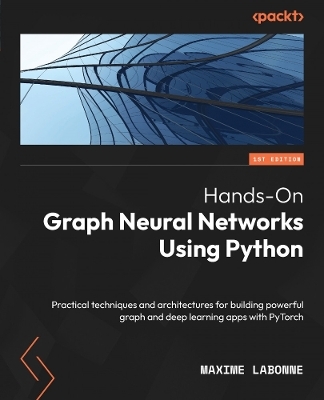
Hands-On Graph Neural Networks Using Python
Packt Publishing Limited (Verlag)
978-1-80461-752-6 (ISBN)
Purchase of the print or Kindle book includes a free PDF eBook
Key Features
Implement -of-the-art graph neural architectures in Python
Create your own graph datasets from tabular data
Build powerful traffic forecasting, recommender systems, and anomaly detection applications
Book DescriptionGraph neural networks are a highly effective tool for analyzing data that can be represented as a graph, such as networks, chemical compounds, or transportation networks. The past few years have seen an explosion in the use of graph neural networks, with their application ranging from natural language processing and computer vision to recommendation systems and drug discovery.
Hands-On Graph Neural Networks Using Python begins with the fundamentals of graph theory and shows you how to create graph datasets from tabular data. As you advance, you’ll explore major graph neural network architectures and learn essential concepts such as graph convolution, self-attention, link prediction, and heterogeneous graphs. Finally, the book proposes applications to solve real-life problems, enabling you to build a professional portfolio. The code is readily available online and can be easily adapted to other datasets and apps.
By the end of this book, you’ll have learned to create graph datasets, implement graph neural networks using Python and PyTorch Geometric, and apply them to solve real-world problems, along with building and training graph neural network models for node and graph classification, link prediction, and much more.What you will learn
Understand the fundamental concepts of graph neural networks
Implement graph neural networks using Python and PyTorch Geometric
Classify nodes, graphs, and edges using millions of samples
Predict and generate realistic graph topologies
Combine heterogeneous sources to improve performance
Forecast future events using topological information
Apply graph neural networks to solve real-world problems
Who this book is forThis book is for machine learning practitioners and data scientists interested in learning about graph neural networks and their applications, as well as students looking for a comprehensive reference on this rapidly growing field. Whether you’re new to graph neural networks or looking to take your knowledge to the next level, this book has something for you. Basic knowledge of machine learning and Python programming will help you get the most out of this book.
Maxime Labonne is currently a senior applied researcher at Airbus. He received a M.Sc. degree in computer science from INSA CVL, and a Ph.D. in machine learning and cyber security from the Polytechnic Institute of Paris. During his career, he worked on computer networks and the problem of representation learning, which led him to explore graph neural networks. He applied this knowledge to various industrial projects, including intrusion detection, satellite communications, quantum networks, and AI-powered aircrafts. He is now an active graph neural network evangelist through Twitter and his personal blog.
Table of Contents
Getting Started with Graph Learning
Graph Theory for Graph Neural Networks
Creating Node Representations with DeepWalk
Improving Embeddings with Biased Random Walks in Node2Vec
Including Node Features with Vanilla Neural Networks
Introducing Graph Convolutional Networks
Graph Attention Networks
Scaling Graph Neural Networks with GraphSAGE
Defining Expressiveness for Graph Classification
Predicting Links with Graph Neural Networks
Generating Graphs Using Graph Neural Networks
Learning from Heterogeneous Graphs
Temporal Graph Neural Networks
Explaining Graph Neural Networks
Forecasting Traffic Using A3T-GCN
Detecting Anomalies Using Heterogeneous Graph Neural Networks
Building a Recommender System Using LightGCN
Unlocking the Potential of Graph Neural Networks for Real-Word Applications
| Erscheinungsdatum | 17.04.2023 |
|---|---|
| Verlagsort | Birmingham |
| Sprache | englisch |
| Maße | 191 x 235 mm |
| Themenwelt | Informatik ► Theorie / Studium ► Künstliche Intelligenz / Robotik |
| Mathematik / Informatik ► Mathematik ► Graphentheorie | |
| ISBN-10 | 1-80461-752-0 / 1804617520 |
| ISBN-13 | 978-1-80461-752-6 / 9781804617526 |
| Zustand | Neuware |
| Informationen gemäß Produktsicherheitsverordnung (GPSR) | |
| Haben Sie eine Frage zum Produkt? |
aus dem Bereich


